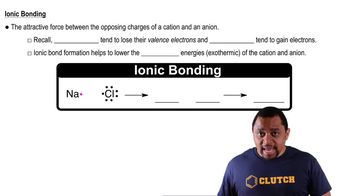Predict the chemical formula of the ionic compound formed between the following pairs of elements: (b) K and S
Ch.8 - Basic Concepts of Chemical Bonding
Chapter 8, Problem 20d
Which ionic compound is expected to form from combining the following pairs of elements? (d) aluminum and oxygen.
 Verified step by step guidance
Verified step by step guidance1
Identify the charges of the ions formed by each element: Aluminum (Al) typically forms a cation with a charge of +3, denoted as \( \text{Al}^{3+} \). Oxygen (O) typically forms an anion with a charge of -2, denoted as \( \text{O}^{2-} \).
Determine the ratio of ions needed to balance the charges: To balance the charges between \( \text{Al}^{3+} \) and \( \text{O}^{2-} \), find the least common multiple of the charges, which is 6.
Calculate the number of each ion needed: To achieve a neutral compound, you need two \( \text{Al}^{3+} \) ions (total charge of +6) and three \( \text{O}^{2-} \) ions (total charge of -6).
Write the formula of the ionic compound: Combine the ions in the ratio determined to form the compound \( \text{Al}_2\text{O}_3 \).
Verify the neutrality of the compound: Check that the total positive charge (+6 from two \( \text{Al}^{3+} \) ions) balances the total negative charge (-6 from three \( \text{O}^{2-} \) ions), confirming the compound is neutral.

Verified video answer for a similar problem:
This video solution was recommended by our tutors as helpful for the problem above.
Video duration:
55sWas this helpful?
Key Concepts
Here are the essential concepts you must grasp in order to answer the question correctly.
Ionic Bonding
Ionic bonding occurs when atoms transfer electrons to achieve full outer electron shells, resulting in the formation of charged ions. Typically, this happens between metals, which lose electrons and become positively charged cations, and nonmetals, which gain electrons to become negatively charged anions. The electrostatic attraction between these oppositely charged ions forms a stable ionic compound.
Recommended video:
Guided course

Chemical Bonds
Aluminum Oxide Formation
When aluminum (a metal) reacts with oxygen (a nonmetal), it forms aluminum oxide (Al2O3). Aluminum has a +3 charge when it loses three electrons, while oxygen typically gains two electrons to achieve a -2 charge. To balance the charges in the compound, two aluminum ions combine with three oxide ions, resulting in the formula Al2O3, which is a common ionic compound.
Recommended video:
Guided course

Enthalpy of Formation
Stoichiometry in Ionic Compounds
Stoichiometry involves the calculation of reactants and products in chemical reactions. In the context of ionic compounds, it helps determine the correct ratio of ions needed to form a neutral compound. For aluminum oxide, the stoichiometric ratio of aluminum to oxygen is 2:3, ensuring that the total positive and negative charges balance out to zero, which is essential for the stability of the ionic compound.
Recommended video:
Guided course

Ionic Compounds Naming
Related Practice
Textbook Question
Textbook Question
Predict the chemical formula of the ionic compound formed between the following pairs of elements: (d) Mg and N
Textbook Question
Which ionic compound is expected to form from combining the following pairs of elements? c. lithium and nitrogen
Textbook Question
Write the electron configuration for each of the following ions, and determine which ones possess noble-gas configurations: a. Rb+ b. Rh3+ c. P3− d. Sc3+ e. S2− f. V2+.
Textbook Question
(b) Write the chemical equation that represents the process of lattice energy for the case of NaCl.
Textbook Question
(c) Would you expect salts like NaCl, which have singly charged ions, to have larger or smaller lattice energies compared to salts like CaO which are composed of doubly-charged ions?
